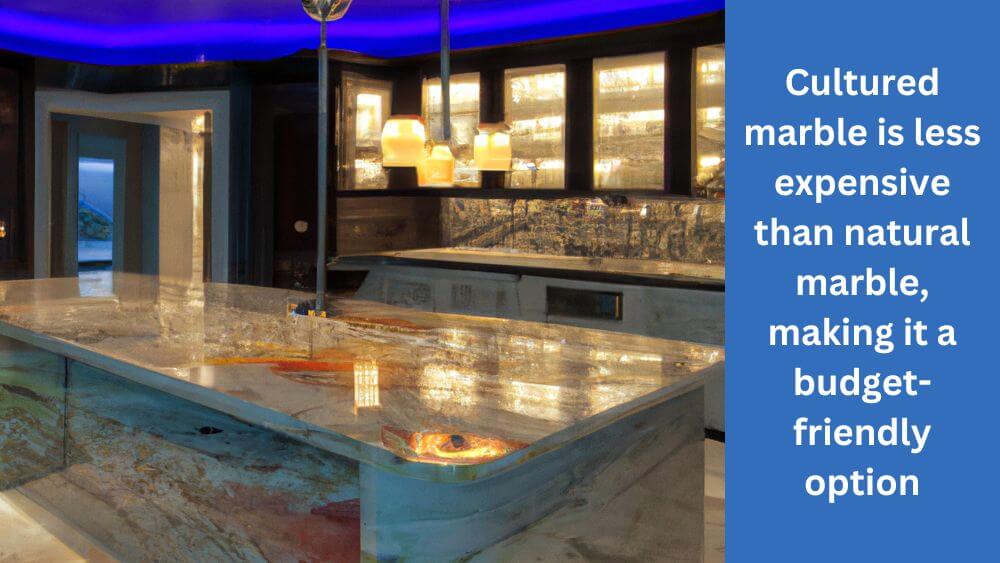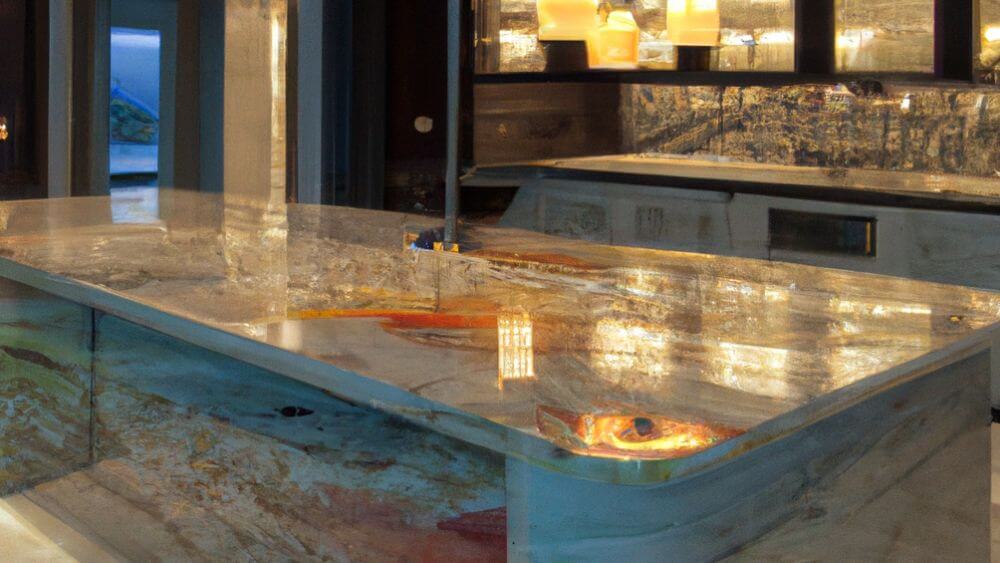Marble is a natural stone that is formed from the metamorphism of limestone. It is known for its unique and luxurious appearance, with various colors and patterns. Marble is a classic choice that adds a touch of luxury to any kitchen countertop.
You have to be aware of the different types of marble available, their unique characteristics, and the pros and cons of using marble in the kitchen. In this blog post, we’ll explore the various types of marble that can be used for kitchen countertops and provide some tips on how to care for them.
Types of marble and their characteristics
Several types of marble are commonly used for kitchen countertops. Here are a few of the most popular options:

Carrara marble
Carrara marble is a white or blue-gray marble quarried in the Carrara region of Italy. It’s known for its elegant appearance and subtle veining, and it has been used for centuries in a variety of applications, including kitchen countertops, floor tiles, and sculpture.
Carrara marble is formed from the metamorphism of limestone, which occurs when the limestone is subjected to heat and pressure over time. This process causes the limestone to recrystallize and form marble. The characteristic white or blue-gray color of Carrara marble is due to the presence of minerals such as calcite and dolomite.
One of the main characteristics of Carrara marble is its subtle veining, which is created by the presence of different minerals and impurities in the marble. The veining can range from thin, delicate lines to bold, dramatic patterns, depending on the specific piece of marble.
Carrara marble is a popular choice for kitchen island countertops due to its durability and classic look. It’s resistant to heat and can last many years with proper care.
Remember, Carrara marble is a pretty porous material, so you need to be careful with spills. If you don’t wipe them up right away, they could stain. Plus, it can easily get scratched, so make sure you use coasters, trivets, and cutting boards to protect it.

Calacatta marble
Calacatta marble is a type of white marble quarried in the Carrara region of Italy, just like Carrara marble. However, Calacatta marble is known for its more luxurious appearance and is considered a higher-end option than Carrara.
Calacatta marble is characterized by its pure white color and dramatic veining, often more pronounced than the veining found in Carrara marble. The veining can range from thin, delicate lines to bold, sweeping patterns, depending on the specific piece of marble.
Calacatta marble is famous for kitchen countertops, bathroom vanities, and other surfaces where a luxurious look is desired. It’s a durable material resistant to heat. Still, it’s important to remember that it is a porous material and can be prone to staining if spills are not wiped immediately. It’s also susceptible to scratching, so it’s important to use coasters, trivets, and cutting boards to protect the surface.
Due to its luxurious appearance and high demand, Calacatta marble is generally more expensive than Carrara marble. However, it’s a timeless choice that can add value to any home.

Statuary marble
Statuary marble is a white marble known for its pure white color and fine, delicate veining. It’s a less common choice for kitchen countertops due to its fragile nature, but it adds a classic and sophisticated look to any space.
Statuary marble is quarried in a variety of locations around the world, including Italy, Greece, and the United States. It is formed from the metamorphism of limestone, which occurs when it is subjected to heat and pressure over time. This process causes the limestone to recrystallize and form marble.
The characteristic white color of Statuary marble is due to the presence of minerals such as calcite and dolomite. Different minerals and impurities create the veining in the marble. The veining is typically fine and delicate and can range from thin, subtle lines to bold, sweeping patterns.
Statuary marble is a durable material resistant to heat. Still, it’s essential to keep in mind that it is a porous material and can be prone to staining if spills are not wiped up immediately. It’s also susceptible to scratching, so it’s important to use coasters, trivets, and cutting boards to protect the surface.
Statuary marble is a beautiful and sophisticated choice for kitchen countertops or other surfaces, but it may require more careful handling and maintenance due to its delicate nature.

Emperador marble
Emperador marble is a type of dark brown marble quarried in various locations around the world, including Spain, Turkey, and the Philippines. It’s known for its rich, luxurious appearance and intricate veining.
Emperador marble is formed from the metamorphism of limestone, which occurs when the limestone is subjected to heat and pressure over time. This process causes the limestone to recrystallize and form marble. Minerals such as hematite and magnetite contribute to Emperador marble’s characteristic dark brown color.
The veining in Emperador marble is typically intricate and detailed, with various patterns and shades of brown. It’s a popular choice for kitchen countertops, bathroom vanities, and other surfaces where a rich, luxurious look is desired.
Emperador marble is a durable material resistant to heat, but it is a porous material that can be prone to staining if spills are not wiped immediately. It’s also susceptible to scratching, so it’s important to use coasters, trivets, and cutting boards to protect the surface.
Overall, Emperador marble is a beautiful and luxurious choice for kitchen countertops or other surfaces, but it may require more careful handling and maintenance due to its porous nature.

Crema Marfil marble
Crema Marfil marble is a type of marble that is quarried in the province of Alicante, Spain. It’s known for its warm, cream-colored base and delicate veining.
Crema Marfil marble is formed from the metamorphism of limestone, which occurs when the limestone is subjected to heat and pressure over time. This process causes the limestone to recrystallize and form marble. The characteristic cream color of Crema Marfil marble is due to the presence of minerals such as calcite and dolomite.
The veining in Crema Marfil marble is typically delicate and subtle, with a variety of different patterns and shades of cream. It’s a popular choice for kitchen countertops, bathroom vanities, and other surfaces where a warm, neutral look is desired.
Crema Marfil marble is a durable material resistant to heat. Still, it’s essential to keep in mind that it is a porous material and can be prone to staining if spills are not wiped up immediately. It’s also susceptible to scratching, so it’s important to use coasters, trivets, and cutting boards to protect the surface.
Crema Marfil marble is a beautiful and versatile choice for kitchen countertops or other surfaces, but it may require more careful handling and maintenance due to its porous nature.

Cultured marble
Cultured marble is an artificial product made from marble dust and polyester resin. It’s a budget-friendly option that is durable and easy to maintain, but it doesn’t have the same natural beauty as real marble.
Cultured marble is created by combining ground marble dust with polyester resin and other materials. The mixture is poured into a mold and cured under heat and pressure. This process creates a solid, durable surface that resembles natural marble.
One of the main benefits of cultured marble is that it is less expensive than natural marble and is more budget-friendly for those who want the look of marble without the high cost. It’s also easier to maintain, as it is not as porous as natural marble and is less prone to staining.
Cultured marble is available in various colors and patterns and can be molded into different shapes and sizes. It’s a popular choice for kitchen countertops, bathroom vanities, and other surfaces where a durable, low-maintenance material is desired.
Overall, cultured marble is a durable and budget-friendly choice for kitchen countertops or other surfaces, but it doesn’t have the same natural beauty as real marble. It’s also less stable and resistant to heat than natural marble.
Pros and cons of using marble for kitchen countertops
Marble is a beautiful and durable choice for kitchen countertops, but it does have its pros and cons. Here are a few things to consider when deciding whether or not to use marble in your kitchen:
Pros:
- Natural beauty: Marble is a natural stone with a unique and luxurious appearance. Each piece of marble is unique, with its veining and color variations.
- Durability: Marble is durable and resistant to heat, making it a good choice for kitchen countertops.
- Heat resistance: Marble is resistant to heat, so you can place hot pots and pans on it without worrying about damaging the surface.
Cons:
- High cost: Marble is more expensive than other materials, such as granite or quartz.
- Susceptibility to staining and scratching: Marble is a porous material that can be prone to staining if spills are not wiped immediately. It can also scratch easily, so it’s essential to be careful when using sharp objects on the surface.
- Need for regular maintenance: Marble requires regular maintenance in the form of cleaning and re-sealing to keep it in good condition.
How to care for marble kitchen countertops
Marble kitchen countertops can last for many years with proper care. Here are a few tips on how to care for your marble countertops:
Use coasters, trivets, and cutting boards
To protect your marble countertops from heat and scratches, it’s important to use coasters under hot pots and pans and place trivets under heavy items. Using cutting boards when preparing food will also help to prevent scratches.
Wipe up spills immediately
Marble is a porous material, so wiping up spills as soon as they occur is essential to prevent staining. Use a pH-neutral cleaner and a soft cloth to clean the surface gently. Avoid using abrasive cleaners or scouring pads, as they can damage the surface.
Use a pH-neutral cleaner
Marble is sensitive to acidic substances, so it’s essential to use it when cleaning your countertops. Avoid using vinegar or citrus-based cleaners, as they can etch the surface of the marble.
Re-seal the surface regularly
Marble should be re-sealed every six to twelve months to keep it in good condition. This helps to protect the surface from stains and makes it easier to clean.
Frequently Asked Question
How does marble compare to other materials for kitchen island countertops?
Marble is a popular choice for kitchen island countertops due to its natural beauty and durability. It is resistant to heat and can last many years with proper care. However, it is a more expensive option than some other materials, such as granite or quartz, and it requires regular maintenance to keep it in good condition.
Can marble scratch easily?
Marble can scratch easily, so it’s essential to be careful when using sharp objects on the surface. It’s also a good idea to use coasters, trivets, and cutting boards to protect the surface from heat and scratches.
How often should I re-seal my marble countertops?
Marble should be re-sealed every six to twelve months to keep it in good condition and protect the surface from stains.
Is marble a durable material?
Marble is a durable material resistant to heat and can last many years with proper care. However, it is susceptible to staining and scratching, so it must be handled carefully and follow reasonable maintenance procedures.
Is cultured marble the same as natural marble?
No, cultured marble is not the same as natural marble. Cultured marble is manufactured from a mixture of marble dust and polyester resin. It is a budget-friendly option that is durable and easy to maintain, but it doesn’t have the same natural beauty as real marble.
Can I use abrasive cleaners on marble countertops?
Avoiding abrasive cleaners or scouring pads on marble countertops is essential, as they can damage the surface.
Can I use vinegar or citrus-based cleaners on marble countertops?
No, it’s important to avoid using vinegar or citrus-based cleaners on marble countertops, as they can etch the surface of the marble.
Can marble countertops be repaired if they are damaged?
In some cases, marble countertops can be repaired if they are damaged. Minor chips or scratches can often be filled and polished to blend in with the rest of the surface. However, deep cracks or significant damage may require more extensive repair or replacement.
Is marble prone to etching?
Marble is prone to etching if it comes into contact with acidic substances, such as vinegar or citrus-based cleaners. Etching occurs when the acid reacts with the surface of the marble and causes a dull, rough area to form.
Can I use marble countertops in a high-traffic kitchen?
You can use marble countertops in a high-traffic kitchen, but it’s essential to be mindful of their delicate nature. Marble is prone to staining and scratching, so it’s important to handle it carefully and follow proper maintenance procedures to keep it in good condition.
Can I cut food directly on a marble countertop?
It’s generally not recommended to cut food directly on a marble countertop, as the sharp edges of a knife can scratch the surface. It’s better to use a cutting board to protect the surface of the marble.
Is marble a good choice for outdoor kitchen countertops?
Marble is not typically a good choice for outdoor kitchen countertops, as it is prone to staining and can be easily damaged by the elements. More durable materials, such as granite or quartz, are better suited for outdoor use.
Conclusion
Marble is a beautiful and durable choice for kitchen countertops, but it’s essential to be aware of its pros and cons before deciding. It’s a more expensive option than some other materials and requires regular maintenance to keep it in good condition. However, its natural beauty and durability make it a classic choice for any kitchen. With proper care, your marble countertops can last for many years.

As the chief content writer, Hassan Al Sarker works as a professional kitchen-based content creator at Kitchen Liker.
In addition to reviewing the content published on Kitchen Liker, he ensures that it is accurate, relevant, and helpful. As a result, all the reviews and information published at Kitchen Liker are neutral and userfriendly.
Hassan Al Sarker has a bachelor’s degree in Hotel and Tourism Management From the Newyork University. Before joining Kitchen Liker, he was a contributor at Kitchen Club, United States.

